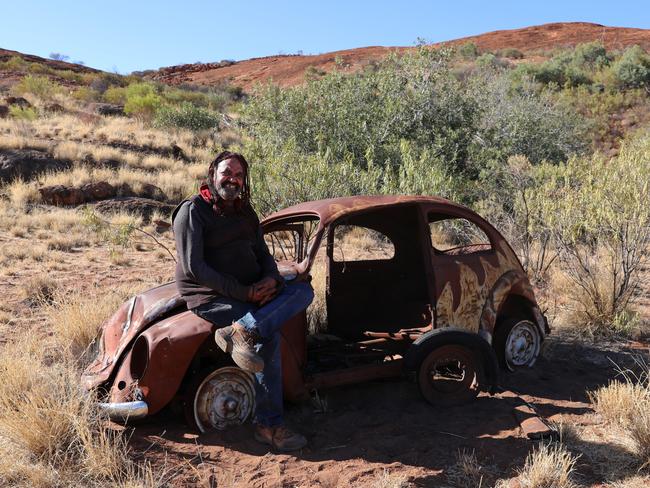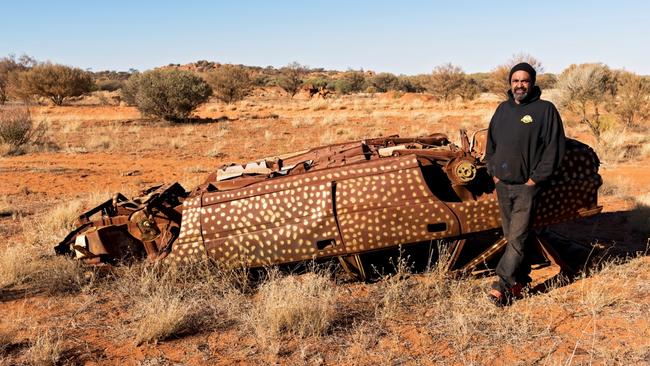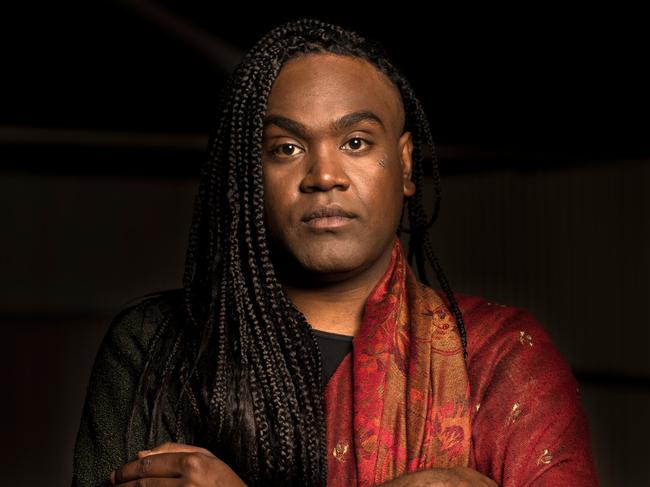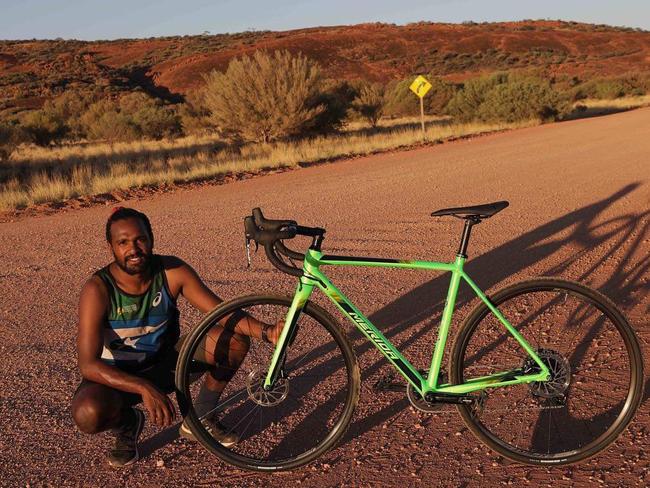On the road again: The artist, the singer and the runner
An old car body from the APY Lands will carry many stories to this year’s Tarnanthi festival, but artist Robert Fielding and his sons Zaachariaha and Zibeon are also creating new tales of success for their remote community.

Arts
Don't miss out on the headlines from Arts. Followed categories will be added to My News.
Hulking carcasses dot the vast desert vistas, slowly decaying beside the seemingly endless stretches of road which link remote communities in South Australia’s far north Anangu Pitjantjatjara Yankunytjatjara Lands.
These are not the remains of native fauna, but vehicles which have met their fate and been left to be consumed by, and become part of, the rust hued landscape.
This was the view that greeted Robert Fielding in 1998 when he decided to move his young family to Mimili, on the traditional lands from which his father had been forcibly removed as a child more than 60 years earlier, never to return.
Now, another 21 years on, those car bodies – one of which will form part of an installation called Mutuka at the Art Gallery of SA for next month’s Tarnanthi indigenous festival – have become vehicles of a different kind, as the carriers of stories in Fielding’s work as an acclaimed visual artist.
At the same time, Robert’s own nine children – in particular sons Zaachariaha, 27, the singer with hit music duo Electric Fields, and Zibeon, 25, an international marathon runner – are helping lead a new generation of indigenous talent from a revitalised Mimili.
In her introduction to this year’s Tarnanthi catalogue, festival artistic director Nici Cumpston says Robert Fielding’s work is among that of a growing number of indigenous artists who respond to the effects of western society, not only on indigenous culture but on the landscape itself.
“The inescapable impacts of non-Aboriginal culture prompt wide-ranging creative responses, from cheerful to challenging,” Cumpston says.
“Robert Fielding jokes that going out bush is like going to the hardware store. In Mutuka, a discarded vehicle found near Mimili and reclaimed by manta (earth), walpa (wind) and kapi (water) is positioned within the gallery space as a container of stories.”

In his own catalogue essay, Robert Fielding says it is true that “one man’s trash is another one’s treasure”.
“Walking and driving around my home of Mimili, there are many relics to be found. We joke that going out bush is like going to the hardware store, or a used car dealership,” Robert writes.
“Many objects lie forgotten and discarded, because they are considered useless or broken.”
He says those discarded items are slowly reclaimed by the earth, wind and water, “which form layers of rust and debris until the object itself becomes hardly recognisable”.
“Through my practice I attempt to bring these objects back to life, finding the unblemished truth that lies under every rusted surface. Part of the salvaging process is dedicated to seeing beyond the object itself, considering the land upon which it rests, the histories of its final movements.”
Robert says car bodies like the one in Mutuka are “reminders of the impermanence and imminent risk every journey entails”.
“The car I chose for Tarnanthi 2019 is one such wreck. Cars in particular do not only carry people but hold many stories. They have long been one of the quickest ways for stories to travel, connecting many cultures and languages.
“The wrecks still resonate with the words once spoken within them. This year, this car will travel once again, very likely on the road it once came from. This time the histories, young and old, of Anangu accompany it.”
Having just returned to Mimili from taking part in the Sydney Contemporary international art fair last weekend, Robert says he is still piecing together the story behind the 1953 Volkswagen, which was in use when many of his people worked as stockmen and station hands.
“People knew of it, but then all of a sudden it disappeared. I found it on my travels,” he says.
“It was rusty. When I painted on it, I painted with gold but I also did all the different pigments of the earth at Mimili, and sandblasted it.

“It’s the storyline of Tjitji Tjuta, the story about the two women, how they were singing out for the children to bring waru (fire). It was a story that was significant for Mimili community.
“The old vehicles that were used, they were prestigious cars and prestigious men and women owned them at that time. They had a lot of value and lot of stories and a lot of travelling.
“The gold spray paint represents the wealth of these people and it also represents how I have restored who I am as a person in life now, and represents power.”
The artist’s late father Bruce was born in 1927 at Lilla Creek, just across the Northern Territory border, but was removed from his mother four years later and initially taken to a mission.
Robert himself was born in 1969 at Port Augusta but raised in Quorn, where his father had also grown up at Colebrook Children’s Home, run by Sisters from the United Aborigines’ Mission. Robert studied at TAFE in Port Augusta, then met his wife, Kaye Lowah, in 1990 and they moved to learn dance with the Aboriginal Dance Theatre in Sydney’s Redfern.
Zaachariaha was born the following year, and the first of his siblings – the boys all bearing Biblical names that start with Z and the girls starting with P – soon followed.
The couple gave up dancing and returned to Port Augusta, but Robert felt compelled to reconnect with his father’s land and people. The move to Mimili in 1998 was difficult on many levels for him and his young family.
“I was going to a place that I did not know – I did not even know the people that I was in the car with. My father had family members here that he did not ever reconcile with. I had to go backwards to go forwards,” Robert recalls.
“I came to Mimili … to rediscover who I was on my father’s side as a Yankunytjatjara person. It’s about holding on to the past, present and future.”
At first, the Fielding children couldn’t understand the indigenous language and wanted to return to Port Augusta.

“They are very bilingual now – you only have to listen to how Zaachariaha performs with Electric Fields (singing lyrics in English, Pitjantjatjara and Yankunytjatjara),” Robert says.
“It’s so important that they rediscovered who they are as custodians of land and country and space.
“I have another son, Zibeon, who is a high-profile person under the Indigenous Marathon Foundation ... he’s run the New York Marathon, he’s run the Boston Marathon, he’s run the Tokyo Marathon. He’s also done an ultra-marathon that ran from Indulkana to Mimili.”
Zaachariaha and Robert Fielding are also featured as part of the SA Film Corporation’s Deadly Family Portraits project, which will screen at the Art Gallery during Tarnanthi and explores how creativity and artistic expression run through certain indigenous families.
The three documentary short films also follow Port Pirie mother and daughter actors Lillian and Elaine Crombie, and Adelaide dancer sisters Taree and Caleena Sansbury.
In the film Electric Mimili, directed by Isaac Lindsay, Zaachariaha returns to the community, where he stands on the bare earth that was his first performance stage.
“When I was growing up all the grandmothers and grandfathers, there’d be about 100 of them, just sitting there singing those old songs,” the singer says.
“This is where a lot of my manifestation and feelings come from. If you have access to those roots, you will grow into whatever you need to be, beautifully, because you just need to know who you are.”

At 13, Zaachariaha left Mimili for boarding school in Adelaide, then briefly attended the Centre for Aboriginal Studies in Music at Adelaide University. He auditioned for the X Factor in 2011 and made the grand final of The Voice in 2014 (with Kristal West, as ZK) before finally finding success in another duo, Electric Fields, with keyboardist and co-producer Michael Ross.
Electric Fields performed at the launch of Tarnanthi in 2017 and won Best New Talent at that year’s National Indigenous Music Awards.
The duo also emerged as the breakout act of the recent SBS national selection show Eurovision – Australia Decides, taking second place with their song 2000 and Whatever during the fan-voted event, behind its well-established winner Kate Miller-Heidke.
Within a day Electric Fields’ single and their EP, Inma, landed in the top 10 on the iTunes singles and albums charts respectively, and a new album is expected to follow soon.
“Every time I have my audience and then I’m performing to them, it’s really crazy … it’s like I’m the therapist but also the patient at the same time,” Zaachariaha says.
“Anangu can move spirit – I’ve watched all of our elders and our ngangkaris (healers) from our community do that with spirit and energy. When I’m on the stage, that’s what I’m doing.”
His brother Zibeon’s ultra-marathon across 63km of desert last year raised $50,000 towards the first dialysis machine to be based in the community, meaning many patients will no longer need to travel to Adelaide or Alice Springs for treatment. The athlete followed this with a 700km bike ride through the region this year, raising $30,000 for a new gym to be built.

Zibeon, who boarded with a local family while attending Mercedes College in Adelaide, now works for Nganampa Health, a federally-funded service on the APY Lands.
While on his fundraising ride, he conducted health checks and ran bike workshops with children in the communities.
“These children of ours, they fundraised and they gave back to the community, to bring the people home, for them to have dialysis on the lands,” father Robert proudly says.
Heredity and tradition both play a part in the passing of talent from one generation to the next, the artist believes.
“From one family, we have artists, we have musicians and we have fitness professionals,” Robert says. “But within our communities, everyone has that story and everyone has strongness and power about their families.”
Tarnanthi is at multiple Adelaide venues from October 18-20 and continues at the Art Gallery of SA until January 27.
Program at agsa.sa.gov.au
